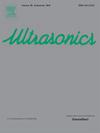串联脉冲序列增强沸腾组织切片的疗效:即时低回声超声检查和扩大病变大小
IF 3.8
2区 物理与天体物理
Q1 ACOUSTICS
引用次数: 0
摘要
煮沸组织术(BH)已被证明是有效的无创崩解各种软组织通过空化效应。虽然液化组织在超声检查中表现为低回声,但在病灶区域,bh诱导的气泡从高回声到低回声的转变通常需要几分钟。为了便于快速临床评估,采用高功率BH脉冲(声功率为1484 W,脉冲持续时间为10 ms,脉冲重复频率为1 Hz)串联脉冲序列,然后采用低功率长超声脉冲(声功率为240 W,脉冲持续时间为100 ms,脉冲重复频率为1 Hz)来加速气泡清除,从而在超声检查中立即出现低回声表现。通过高速摄影、红细胞幻影和离体组织实验对该方法进行了评价。高速摄影实验捕捉到由低功率长脉冲引起的气泡间隙增强,验证了我们的假设。在RBC幻影实验中,常规脉冲序列在4.39±0.84 min后产生低回声,而串联脉冲序列在处理后立即产生低回声(p <;0.05)。此外,串联脉冲序列使RBC层的侵蚀面积增加了7.8倍,从2.36±0.88 mm2增加到18.43±5.15 mm2 (p <;0.05),在等效能量输出下。离体牛肝脏实验反映了这些发现,在>;10 min vs. 0 min (p <;0.05),液化面积分别为33.78±3.28 mm2和66.52±11.24 mm2 (p <;分别为0.05)。综上所述,我们的研究结果表明,对空化活动的战略性调节不仅加速了超声成像中的即时低回声表现,而且扩大了bh诱导解体的面积。串联脉冲序列策略在临床应用中为提高BH治疗的疗效和效率提供了一条有希望的途径。本文章由计算机程序翻译,如有差异,请以英文原文为准。
Enhancing boiling histotripsy efficacy with a tandem pulse sequence: Immediate hypoechoic Sonograhy and expanded lesion size
Boiling histotripsy (BH) has proven effective in noninvasively disintegrating various soft tissues through cavitation effects. Although liquefied tissue appears as hypoechoic in sonography, the transition of BH-induced bubbles from hyperechoic to hypoechoic in the focal region typically requires several minutes. To facilitate rapid clinical assessment, a tandem pulse sequence of high-power BH pulses (with an acoustic power of 1484 W, a pulse duration of 10 ms, and a pulse repetition frequency of 1 Hz) followed by low-power long ultrasound pulses (with an acoustic power of 240 W, a pulse duration of 100 ms, and a pulse repetition frequency of 1 Hz) was introduced to expedite bubble clearance, resulting in an immediate hypoechoic presentation in sonography. This method was evaluated through high-speed photography, red blood cell (RBC) phantom, and ex vivo tissue experiments. High-speed photography experiments captured the enhanced bubble clearance induced by the low-power long pulses, validating our hypothesis. In RBC phantom experiments, conventional BH sequences yielded hypoechic patterns after 4.39 ± 0.84 min, whereas the tandem pulse sequences achieved hypoechic appearance instantaneously post-treatment (p < 0.05). Moreover, the tandem pulse sequences increased the erosion area in the RBC layer by 7.8 folds, from 2.36 ± 0.88 mm2 to 18.43 ± 5.15 mm2 (p < 0.05), at the equivalent energy output. Ex vivo bovine liver experiments mirrored these findings, with hypoechoic appearance at > 10 min vs. 0 min (p < 0.05) and liquefied areas of 33.78 ± 3.28 mm2 vs. 66.52 ± 11.24 mm2 (p < 0.05), respectively. In summary, our results suggest that the strategic modulation of cavitation activities not only accelerates the immediate hypoechoic appearance in sonography but also enlarges the area of BH-induced disintegration. The tandem pulse sequence strategy presents a promising avenue for enhancing the efficacy and efficiency of BH treatment in clinical applications.
求助全文
通过发布文献求助,成功后即可免费获取论文全文。
去求助
来源期刊

Ultrasonics
医学-核医学
CiteScore
7.60
自引率
19.00%
发文量
186
审稿时长
3.9 months
期刊介绍:
Ultrasonics is the only internationally established journal which covers the entire field of ultrasound research and technology and all its many applications. Ultrasonics contains a variety of sections to keep readers fully informed and up-to-date on the whole spectrum of research and development throughout the world. Ultrasonics publishes papers of exceptional quality and of relevance to both academia and industry. Manuscripts in which ultrasonics is a central issue and not simply an incidental tool or minor issue, are welcomed.
As well as top quality original research papers and review articles by world renowned experts, Ultrasonics also regularly features short communications, a calendar of forthcoming events and special issues dedicated to topical subjects.
 求助内容:
求助内容: 应助结果提醒方式:
应助结果提醒方式:


